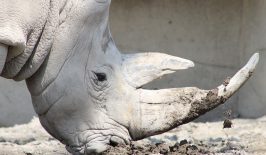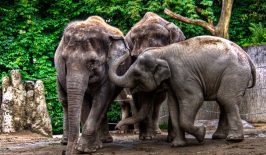The illegal trade in wild animals and plants generates an estimated annual turnover of nine to 23 billion US dollars. This puts this form of crime in fourth place among organized crime worldwide – behind drug and human trafficking and product piracy. Millions of tons of wood, seafood and other wild animal products enter the black market every year; often in processed form, such as furniture, carvings, powders or oils which makes it difficult to identify the species involved. While being able to identify and confirm the source of products like this – and ensure they don’t come from endangered species – is key to being able to conserve wildlife and protect the planet’s biodiversity.
A supermarket-style barcode scanner
The non-profit startup Conservation X Labs from Washington DC is working on the development of a so-called DNA barcode scanner in a bid to democratise access to genetic analysis. DNA analysis is actually an excellent way of determining the source of an animal or plant product, but its application is still limited.
With the help of this new scanner, a product sample can now be determined at species level within minutes. First, a small piece of tissue is taken from the sample. Together with water and a cleaning agent, the DNA contained in it is then introduced into a solution. This mixture is then applied to a cartridge, which is inserted into the scanner for the identification process.
We’re all aware of the barcodes found on products in the supermarket. Similar to these, there are certain short gene segments that are unique for each species. These are known as DNA barcodes and they form the global standard for the identification of species. The Conservation X Labs device uses the reference database Barcode of Life Database (BOLD) to compare the sample.
The scanner is designed to be usable anywhere in the world, but particularly with the idea of making it accessible to the less industrialised countries that are often the source of illegal natural products. It is in these areas that this kind of technology is most needed – i.e. in the field (at the point of processing and in the early stages of the supply chains) – but these are also where genetic analysis technology tends not to be readily available. Due to its small size, the scanner is portable and affordable. It is easy to use without any prior training, and does not require the user to be able to read or write. It even works without a continuous power supply.
The DNA Barcode Scanner is Conservation X Labs’ first commercial product, and began life as part of the doctoral thesis of Dr. Hal Holmes, the current Chief Product Engineer. Several prototypes have already been created and tests carried out with potential customers. The device is expected to be launched towards the end of 2019 at a price of approximately 100 USD. There are many potential users for the technology: customs and border guards, employees of the Fisheries Control Agency, supply chain managers, but also scientists, conservationists or even everyday citizens.
The overriding mission of Conservation X Labs is to end the man-made extinction of plant and animal species. Alex Dehgan, CEO and co-founder of the startup, believes that while conventional conservation science “can help define the problems, it alone does not possess the solutions”. And so Conservation X Labs wants to approach conservation in a new way – exploring the use of technology to tackle the issues and bring together experts from different disciplines to develop solutions. The company regularly advertises prizes and competitions to promote technological innovations related to biodiversity conservation, that inevitable bring engineers, biologists, designers, entrepreneurs and anthropologists together. Interdisciplinarity appears to be the key for the future of nature conservation.
However, technological developments can only ever offer a partial solution to a larger problem. The social entanglements behind the issue of illegal trafficking often run much deeper: many poachers lack alternatives to escape poverty. And unstable political structures often also play a role. Nevertheless, by improving access to DNA analysis tools, it could prove to be an important tool in the fight against illegal plant and animal trafficking.
This is a translation of an original article which first appeared on RESET’s German-language site.






